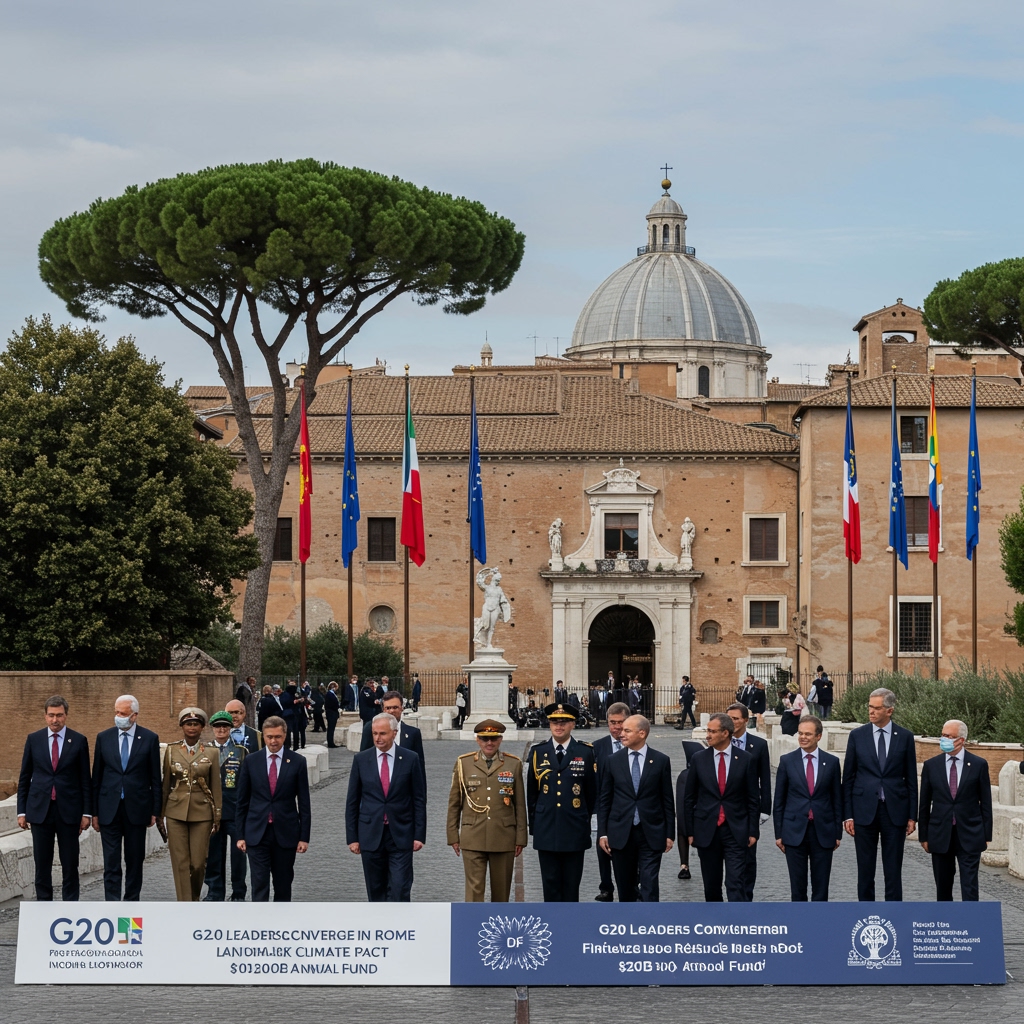G20 Leaders Meet in Rome for Critical Climate Summit
ROME, Italy – Leaders from the Group of Twenty (G20) nations have converged this week in the historic city of Rome, Italy, for a pivotal summit aimed at finalizing the Global Climate Resilience Pact. This ambitious and far-reaching international treaty, which saw its initial drafting completed in late 2024, is poised to become a cornerstone of global efforts to combat climate change and build a more sustainable future.
The summit in Rome represents the culmination of extensive negotiations and diplomatic efforts, bringing together the heads of state and government from the world’s largest economies, responsible for a significant majority of global greenhouse gas emissions. The urgency of the meeting reflects the accelerating impacts of climate change and the scientific consensus that drastic action is needed to prevent the most severe consequences.
Core Provisions of the Global Climate Resilience Pact
The Global Climate Resilience Pact is designed to move beyond voluntary commitments towards a more binding and accountable framework for climate action. A central tenet of the treaty includes provisions for binding national emissions reduction targets. These mandatory targets are not set to begin immediately upon ratification but are scheduled to come into effect starting in 2026. This timeline is intended to provide signatory nations with a brief period for preparation and domestic policy adjustments, while still ensuring rapid implementation of emissions cuts.
In addition to direct emissions targets, the pact also includes significant investment mandates for green infrastructure. This encompasses a wide array of initiatives, from scaling up renewable energy capacity and developing smart grids to investing in sustainable transportation, energy efficiency upgrades, and climate-resilient urban planning. The goal is to trigger a massive global shift in investment flows towards low-carbon and resilient development pathways.
Securing Financial Commitments for Climate Adaptation
A key, and reportedly the most challenging, focus of the Rome summit is securing firm financial commitments from developed economies. Climate finance has historically been a contentious issue in international climate negotiations, with developing nations arguing for greater support from countries that have contributed the most to historical emissions. The Global Climate Resilience Pact aims to address this head-on by including specific mandates for financial aid.
Reports from the negotiation rooms indicate intense discussions around the scale of this funding, with a clear objective to secure commitments reportedly aiming for over $100 billion annually from developed nations. This substantial sum is earmarked to aid climate adaptation and mitigation efforts in developing nations. Climate adaptation, which involves building resilience to the unavoidable impacts of warming already in the system (such as rising sea levels, extreme weather events, and drought), is particularly critical for vulnerable countries and communities.
Discussions involve not only the total amount but also the mechanisms for disbursement, ensuring transparency, predictability, and accessibility of funds. Developing nations stress the need for this finance to be in the form of grants rather than loans, to avoid burdening their economies with additional debt. The successful negotiation of this financial package is widely seen as crucial for building trust and enabling developing countries to participate fully and effectively in the pact’s implementation.
Significance in the Context of the 1.5-Degree Limit
The Global Climate Resilience Pact is viewed by proponents as absolutely crucial for accelerating global action towards the critical 1.5-degree Celsius warming limit established under the Paris Agreement. Scientific reports consistently highlight that exceeding this threshold significantly increases the risk of triggering irreversible climate feedback loops and leads to far more severe and widespread impacts on human societies and natural ecosystems.
The binding nature of the emissions targets starting in 2026 and the dedicated financial resources for adaptation are intended to inject new urgency and capacity into the global fight against climate change. The G20 nations, collectively representing such a dominant force in the global economy and emissions landscape, reaching a definitive agreement on this pact in Rome would send a powerful signal to the rest of the world and could potentially mobilize further action from other nations and international bodies.
However, challenges remain. Translating the pact’s provisions into effective domestic policies and ensuring compliance with binding targets requires strong political will and robust national frameworks. The negotiations in Rome are thus not merely about finalizing text on paper, but about cementing the political buy-in and securing the tangible resources necessary to make the Global Climate Resilience Pact a successful instrument in averting climate catastrophe.
As the summit progresses, the world watches keenly, hopeful that the leaders of the G20 can overcome remaining hurdles and deliver a pact that provides the necessary framework and financial muscle to steer the planet towards a more resilient and sustainable future, keeping the ambition of the 1.5-degree Celsius limit within reach.





